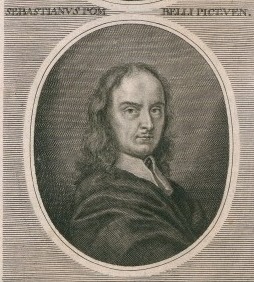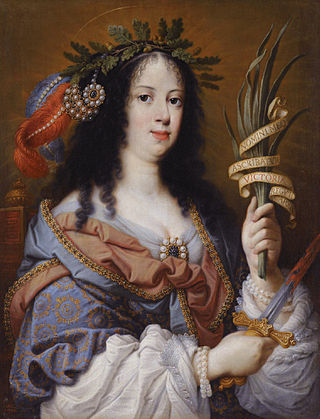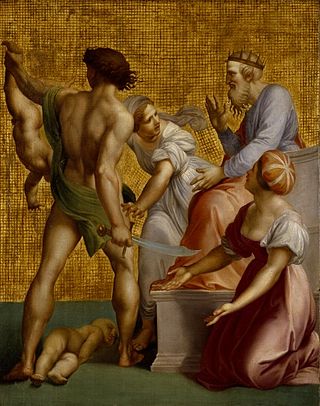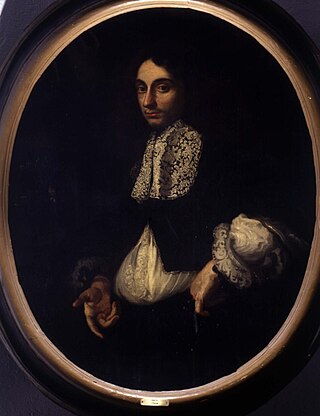Related Research Articles

Giovanni Battista Tiepolo, also known as GiambattistaTiepolo, was an Italian painter and printmaker from the Republic of Venice who painted in the Rococo style, considered an important member of the 18th-century Venetian school. He was prolific, and worked not only in Italy, but also in Germany and Spain.

Domenico Veneziano was an Italian painter of the early Renaissance, active mostly in Perugia and Tuscany.

Domenico Fetti was an Italian Baroque painter who was active mainly in Rome, Mantua and Venice.

Antonio Balestra was an Italian painter of the Rococo period.

Gaspare Diziani was an Italian painter of the late-Baroque or Roccoco period, active mainly in the Veneto but also in Dresden and Munich. The artist's canvas is the largest painting of the Hermitage Museum in St. Petersburg.

Sebastiano Bombelli was an Italian painter, mainly active in Venice, during the Baroque period.

Mario Balassi (1604–1667) was an Italian painter of the Baroque period, active in Florence and Rome.

Domenico Campagnola was an Italian painter and printmaker in engraving and woodcut of the Venetian Renaissance, but whose most influential works were his drawings of landscapes.

Giovanni Antonio Fumiani (1645–1710) was an Italian painter of the Baroque period.
Giuseppe Baroni was an Italian engraver of the 18th century. Together with Domenico Rosetti and Andrea Zucchi, he completed the prints for Il gran Teatro delle pitture e prospettive di Venezia, published in Venice in 1720 by Domenico Loviso in the Rialto. In this collection, the Madonna and child print by Nicolas Poussin and the Polyphemus by Pompeo Battoni are attributed to Baroni.

Marco Ricci was an Italian painter of the Baroque period.
Alfonso Aldiverti was an Italian painter of the early Baroque period, active mainly in Rovigo.

Giuseppe Cades was an Italian sculptor, painter, and engraver.

Giuseppe Camerata (1718–1803) was an Italian miniaturist painter and engraver.

Antonio Capellani was an Italian engraver. He was born at Venice, where he was a pupil of Joseph Wagner, and engraved several plates both at Rome and Venice. He engraved most of the portraits in the edition of Vasari, published by Bottarini at Rome in 1760. He also engraved several of the plates for the Schola Italia Picturae under the direction of Gavin Hamilton.

Domenico Carpinoni was an Italian painter of the Renaissance period. He was born at Clusone in the Valle Seriana. He was sent to Venice when young, and became a pupil of the younger Palma il Giovane. He painted a Birth of St. John the Baptist and Descent from the Cross for the principal church of Clusone a Transfiguration for the Chiesa di Monasterolo del Castello in the Valle Cavallina, and an Adoration of the Magi for the church of the Padri Osservanti at Lovere.

Giovanni Bernardo Carbone was an Italian painter of the Baroque period.

Domenico Robusti, also known as Domenico Tintoretto, was an Italian painter from Venice. He grew up under the tutelage of his father, the renowned painter Jacopo Tintoretto.

Antonio Baratti was an Italian engraver, etcher and printmaker.

Davide Antonio Fossati, a painter and etcher, was bom at Morcote, Ticino, Switzerland in 1708, and studied drawing under Vicenzo Maria Mariotti at Venice, and painting under Daniel Gran, with whom in 1723 he went to Vienna. In 1728 he painted the dining-hall in the monastery of St. Martinsberg at Pressburg; but in 1730 he returned to Venice, and in the next year executed the wall-paintings in the villa at Torre, near Este, as also in the nunnery of Santa Margaretta, near Lauis. He afterwards took to etching, but did not succeed at first. His death occurred at Vienna in 1795. His works as a painter are little known, but he has left among his later and happier efforts several etchings of landscapes and historical subjects after various masters.
References
 This article incorporates text from a publication now in the public domain : Bryan, Michael (1886). "Fossati, Domenico". In Graves, Robert Edmund (ed.). Bryan's Dictionary of Painters and Engravers (A–K). Vol. I (3rd ed.). London: George Bell & Sons.
This article incorporates text from a publication now in the public domain : Bryan, Michael (1886). "Fossati, Domenico". In Graves, Robert Edmund (ed.). Bryan's Dictionary of Painters and Engravers (A–K). Vol. I (3rd ed.). London: George Bell & Sons.